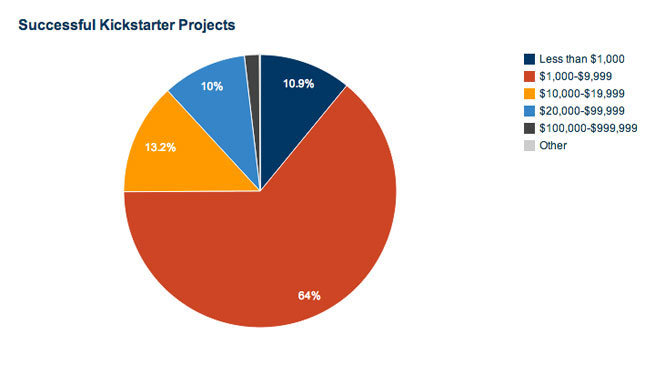It always saddens me when I find an interesting crowdfunding project that I know is going to fail. And it frustrates me when I find a project that I would support—if only they’d given me a reason to do so. But they didn’t, and so I don’t. In the interest of keeping others from making the mistakes that I see so often—and in the hope that more people will plan for successful crowdfunding campaigns—here is my list of 8 essential steps to take before you launch your campaign:
-
Set a realistic goal. On Kickstarter, 75% of funded projects raise less than $10,000. Check out the chart below for more details. Before you start a campaign, ask yourself how much you really need and whether you have an audience that can help get you there.
-
Leverage your personal network. Without your network, you won’t get far. Crowdfunding isn’t free money. According to Kickstarter, 80% of projects that raise at least 20% of their target are ultimately successful. To take that a step further, 98% of projects that raise at least 60% of their target finish with success. Can your fans get you to 20%? That’s a great start. How about 60%? Then you’re almost guaranteed a successful close. On that note…
-
Make sure your crowd can use the Interwebs. This sounds like a duh, but I’ve consulted on a crowdfunding project where the supporters needed step-by-step instructions to leave pledges. The project was ultimately successful, but it took a lot of coaching on the part of its creators to get fans to the crowdfunding site and submitting pledges.
-
Engage, engage, engage. Announce your project well in advance of its launch and post frequent updates while it’s open. In that vein, it may seem like a good idea to have a long—even unlimited—project duration, but shorter projects actually fare better. Take a lesson from the ever-more-sensationalized television news: People’s attention spans are short. Grab ’em and keep ’em engaged.
-
Start your rewards small. The most popular pledge amount is $25, and 90% of pledges fall below $100. Can you begin your rewards as low as $1 or $5? Do it.
-
Make your rewards compelling. Look at your reward options from an outsider’s perspective. What would make you pull out your hard-earned cash and plunk it down in support of a project? If you’re fundraising for photography, build postcards, signed prints, books, and photo experiences into your reward list.
-
Ensure your rewards make sense, and make it easy for people to move up your pledge ladder. Yep, this is my third tip focused on rewards. Your rewards are make-it-or-break-it material. They are also a ladder, one that should entice your fans upward and make it easy for them to join the fun. Ideally, make each reward build on the next. For example:
- $1 or more: Our deepest thanks and continued project updates.
- $5 or more: All of the above, plus a personalized thank you note.
- $10 or more: All of the above, plus a 4×6 mini print from the project.
- $25 or more: All of the above, plus a project t-shirt.
- $50 or more: All of the above, plus a signed 8×10 print from the project.
- $75 or more: A signed 11×14 print, plus everything from the $25 reward level.
- $150 or more: A signed copy of our new book, plus everything at the $75 reward level.
Are you getting the idea? The last thing you want is for someone to desire something you offered at a lower reward level that they can’t get further up the ladder. It caps their support and yours. Note: This is just one example of a successful reward ladder. Brainstorm and think outside the box to plan your own.
-
Be prepared to invest significant time to make your project a success. Managing a crowdfunding campaign is hard work. Share your passion, persistently but kindly. Reach out to influential friends for co-creation at higher reward levels (for example, a book signed by all of your photography subjects, if they’re well known, or a portrait session with you and a cool friend.) And make it personal. Personalized outreach is always more successful than form letters. If you need help, hire a virtual assistant or engage a friend. It’s always easier to stay motivated when more people are on board.

Bottom line: Plan for success. Or you may be destined for failure.
Do you have any tips that I missed? Please feel free to add them in the comments. And, if you have any questions about launching a successful crowdfunding campaign, please feel free to reach out. I love hearing from you!
Cheers,

















Kate Watson - Thanks, Corinne! Glad you found it helpful.
corinne - This is super helpful Kate! I don’t plan on starting a Kickstarter Project, but you never know who will benefit from this information.